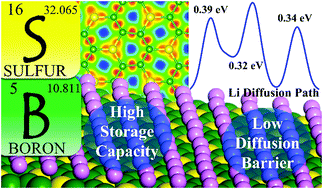B3S monolayer: prediction of a high-performance anode material for lithium-ion batteries†
Abstract
To mitigate the ever-growing global temperature rise, renewable energy is needed and use of fossil fuels has to be reduced on an urgent basis. Next-generation renewable energy technology demands electrode materials with suitable structural, electronic, and mechanical properties. Through particle swarm-intelligence and first-principles structure calculations, we have designed a new novel B3S monolayer, which is dynamically, mechanically, and thermally stable and of higher cohesive energy compared to synthesized B2S3 thus ensuring the feasibility of experimental synthesis. As an anode material, the B3S monolayer can be expected to have high performance with high storage capacity (1662 mA h g−1), low open-circuit voltage (∼0.16 V) and a low lithium diffusion barrier (Ea < 0.4 eV). Furthermore, the metallicity of the B3S monolayer is sustained after lithium adsorption, indicating good electrical conductivity and battery operating cycle. Our results clarify that these intriguing properties make B3S monolayer an appealing candidate for anode material in lithium-ion batteries.



 Please wait while we load your content...
Please wait while we load your content...